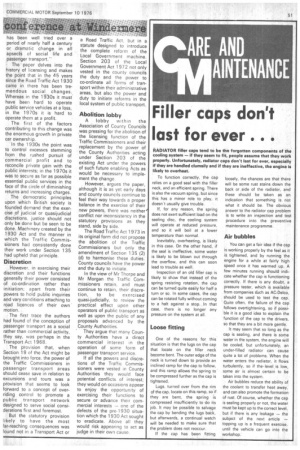Filler caps don't last for ever . . .
Page 53

If you've noticed an error in this article please click here to report it so we can fix it.
RADIATOR filler caps tend to be the forgotten components of the cooling system — if they seem to fit, people assume that they work properly. Unfortunately, radiator caps don't last for ever, especially if they are handled clumsily and if they are ineffective, the engine is likely to overheat.
To function correctly, the cap relies on a good seal with the filler neck, and an efficient spring. There is also the vacuum spring, but since this has a minor role to play, it doesn't usually give trouble.
lf, for any reason, the spring does not exert sufficient load on the sealing disc, the cooling system will operate at reduced pressure, and so it will boil at a lower temperature than normal.
Inevitably, overheating, is likely in this case. On the 'other hand, if the seal is ineffective, some water is likely to be blown out through the overflow, and this can soon lead to trouble as well.
Inspection of an old filler cap is likely to show that instead of the spring resisting rotation, the cap can be turned quite easily for half a turn or so. In some cases, the cap can be rotated fully without coming to a halt against a stop. , In that case, there is no longer any pressure on the system at all.
Loose fitting One of the reasons for this situation is that the lugs on the cap that locate on the filler neck become bent. The outer edge of the neck is turned down to provide an inclined ramp for the cap to follow, and this ramp allows the spring to be compressed further as the cap is tightened.
Lugs, turned over from the rim of the cap, locate on this ramp, so if they are bent, the spring is compressed insufficiently to do its job. It may be possible to salvage the cap by bending the lugs back, but afterwards, a continual watch will be needed to make sure that the problem does not reoccur.
If the cap has been fitting loosely, the chances are that there will be some rust stains down the back or side of the radiator, and these should be taken as an indication that something is not what it should be. The obvious answer to the radiator cap problem is to write an inspection and test procedure into the preventive maintenance programme.
Air bubbles You can get a fair idea if the cap is working properly by the feel as it is tightened, and by running the engine for a while at fairly high speed once it has warmed up. A few minutes running should indicate whether the cap is functioning correctly. If there is any doubt, a pressure tester, which is available from companies 'uch as AC-Delco, should be used to test the cap.. Quite often, the failure of the cap follows over-tightening, so if possible it is a good idea to explain the function of the cap to the drivers, so that they are a bit more gentle.
It may seem that so long as the cap is sealing, and there is some water in the system, the engine will be cooled, but unfortunately, an under-filled radiator can cause quite a lot of problems. When the water enters the radiator, it flows turbulently, so if thelevel. is low, some air is almost certain to be taken into the system.
Air bubbles reduce the ability of the coolant to transfer heat away, and can also promote the formation of rust. Of course, whether the cap is sealing properly or not, the water must be kept up to the correct level, but if there is any leakage — the subject of the next article — topping up is a frequent exercise, until the vehicle can go into the workshop.




























































































